ShipCon Erasmus+ training courses give you opportunity to discover Prague. The bohemian allure and fairytale features of Prague make it a perfect destination for culture vultures who want to immerse themselves in history, art, music, and architecture.

WHY PRAGUE
Prague is one of the most popular destinations in East Central Europe. The allure of the historic baroque architecture, welcoming population, and delicious fare brings in visitors from across the globe—but you shouldn’t go to Prague simply because everyone else goes.
SHIPCON ERASMUS+ PREMISES – PRAGUE

ERASMUS+ IN PRAGUE
Prague, capital city of the Czech Republic, is bisected by the Vltava River. Nicknamed “the City of a Hundred Spires,” it’s known for its Old Town Square, the heart of its historic core, with colorful baroque buildings, Gothic churches and the medieval Astronomical Clock, which gives an animated hourly show. Completed in 1402, pedestrian Charles Bridge is lined with statues of Catholic saints.
PLACES TO VISIT IN PRAGUE
-
Astronomical Clock in Old Town
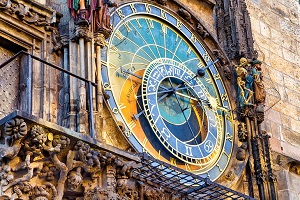 A highlight is the Old Town Hall (Staromestská radnice), home to the wonderful early 15th-century Astronomical Clock (orloj). Each hour, it springs to life as the 12 Apostles and other figures appear and parade in procession across the clock face. Other Old Town Hall highlights are the Gothic doorway leading to its splendid interior with its art exhibits and displays, a chapel built in 1381, and an old prison. Be sure to make the ascent (by stairs or elevator) to the top of the Old Town Hall Tower for its fine views over Prague.
A highlight is the Old Town Hall (Staromestská radnice), home to the wonderful early 15th-century Astronomical Clock (orloj). Each hour, it springs to life as the 12 Apostles and other figures appear and parade in procession across the clock face. Other Old Town Hall highlights are the Gothic doorway leading to its splendid interior with its art exhibits and displays, a chapel built in 1381, and an old prison. Be sure to make the ascent (by stairs or elevator) to the top of the Old Town Hall Tower for its fine views over Prague.
-
Prague Castle
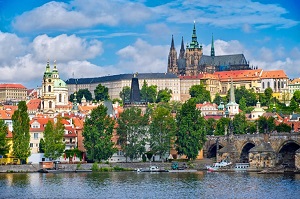 Located in Prague’s Hradcany neighborhood, Prague Castle (Pražský hrad), once the home of Bohemia’s kings, is today the official residence of the Czech Republic’s President and one of the city’s most visited tourist attractions. Originally built as a walled fortress around AD 870, the castle has changed dramatically over the years and contains examples of most of the leading architectural styles of the last millennium.
Located in Prague’s Hradcany neighborhood, Prague Castle (Pražský hrad), once the home of Bohemia’s kings, is today the official residence of the Czech Republic’s President and one of the city’s most visited tourist attractions. Originally built as a walled fortress around AD 870, the castle has changed dramatically over the years and contains examples of most of the leading architectural styles of the last millennium.
-
Charles Bridge
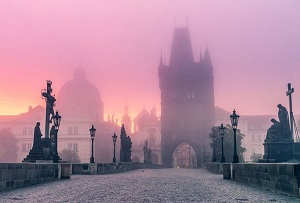 One of the most recognizable old bridges in Europe, magnificent Charles Bridge (Karluv Most) boasts 32 unique points of interest along its 621-meter span. Built in 1357, the bridge has long been the subject of a great deal of superstition, including the builders having laid the initial bridge stone on the 9th of July at exactly 5:31am, a precise set of numbers (135797531) believed to give the structure additional strength. For added good measure, it was constructed in perfect alignment with the tomb of St. Vitus and the setting sun on the equinox.
One of the most recognizable old bridges in Europe, magnificent Charles Bridge (Karluv Most) boasts 32 unique points of interest along its 621-meter span. Built in 1357, the bridge has long been the subject of a great deal of superstition, including the builders having laid the initial bridge stone on the 9th of July at exactly 5:31am, a precise set of numbers (135797531) believed to give the structure additional strength. For added good measure, it was constructed in perfect alignment with the tomb of St. Vitus and the setting sun on the equinox.
-
Wenceslas Square
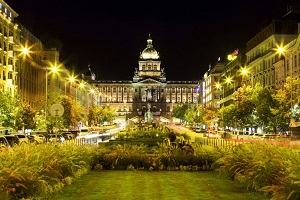 A highlight of Prague’s New Town (Nové Mesto) district—an area that grew out of the city’s need to expand as it prospered—is the wonderful Wenceslas Square (Václavské námestí), home to the National Museum and numerous other architectural treasures. Named after the patron saint of Bohemia, whose statue can be seen here, Wenceslas Square was created in the 14th century during the reign of Charles IV as a horse market and has since become one of the city’s most important public spaces, still used for demonstrations and celebrations alike.
A highlight of Prague’s New Town (Nové Mesto) district—an area that grew out of the city’s need to expand as it prospered—is the wonderful Wenceslas Square (Václavské námestí), home to the National Museum and numerous other architectural treasures. Named after the patron saint of Bohemia, whose statue can be seen here, Wenceslas Square was created in the 14th century during the reign of Charles IV as a horse market and has since become one of the city’s most important public spaces, still used for demonstrations and celebrations alike.
-
The National Museum
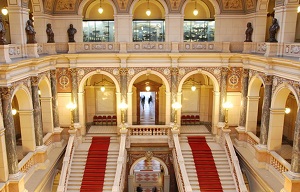 Fresh from a seven-year-long renovation, the National Museum (Národní Muzeum) in Prague is spread across a number of locations and houses numerous important collections representing a variety of fields, with literally millions of items covering mineralogy, zoology, anthropology, and archaeology, as well as the arts and music. The entomology collection alone numbers more than five million specimens. The oldest museum in the Czech Republic, it was established in the early 1800s before moving to its current location in 1891.
Fresh from a seven-year-long renovation, the National Museum (Národní Muzeum) in Prague is spread across a number of locations and houses numerous important collections representing a variety of fields, with literally millions of items covering mineralogy, zoology, anthropology, and archaeology, as well as the arts and music. The entomology collection alone numbers more than five million specimens. The oldest museum in the Czech Republic, it was established in the early 1800s before moving to its current location in 1891.
-
St. Vitus Cathedral
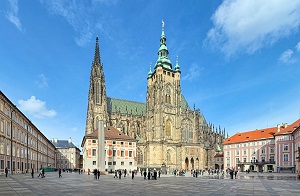 Situated within the grounds of Prague Castle, the Roman Catholic St. Vitus Cathedral (Katedrala St. Vita) is the Czech Republic’s largest and most important Christian church. Seat of the Archbishop of Prague, it’s also home to the tombs of numerous saints and three Bohemian kings. Founded on the site of a Romanesque rotunda built in AD 925, the cathedral was started in 1344 and took more than 525 years to complete, resulting in a mix of modern Neo-Gothic and 14th-century Gothic styles, along with Baroque and Renaissance influences (be sure to keep an eye out for the impressive gargoyles adorning the exterior of the cathedral).
Situated within the grounds of Prague Castle, the Roman Catholic St. Vitus Cathedral (Katedrala St. Vita) is the Czech Republic’s largest and most important Christian church. Seat of the Archbishop of Prague, it’s also home to the tombs of numerous saints and three Bohemian kings. Founded on the site of a Romanesque rotunda built in AD 925, the cathedral was started in 1344 and took more than 525 years to complete, resulting in a mix of modern Neo-Gothic and 14th-century Gothic styles, along with Baroque and Renaissance influences (be sure to keep an eye out for the impressive gargoyles adorning the exterior of the cathedral).
-
The Hilltop Fortress: Vyšehrad
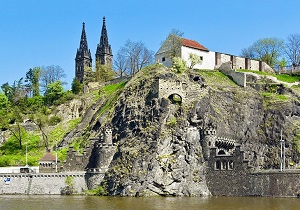 Looking like something out of a fairy tale, the Vyšehrad fortress—literally translated as the “Upper Castle,” or the “Castle on the Heights”—stands high above the Vltava River overlooking Prague. Known to have been in existence as far back as the 10th century, it has long been the subject of myth and legend, including the foretelling of an ancient princess of the rising of a great city around it. Once the royal residence of Vratislav II, Vyšehrad also played a role as part of the original Royal Route taken by kings about to be crowned, who would have to stop here to pay tribute to their predecessors (the route led from Vyšehrad to Hradcany).
Looking like something out of a fairy tale, the Vyšehrad fortress—literally translated as the “Upper Castle,” or the “Castle on the Heights”—stands high above the Vltava River overlooking Prague. Known to have been in existence as far back as the 10th century, it has long been the subject of myth and legend, including the foretelling of an ancient princess of the rising of a great city around it. Once the royal residence of Vratislav II, Vyšehrad also played a role as part of the original Royal Route taken by kings about to be crowned, who would have to stop here to pay tribute to their predecessors (the route led from Vyšehrad to Hradcany).
